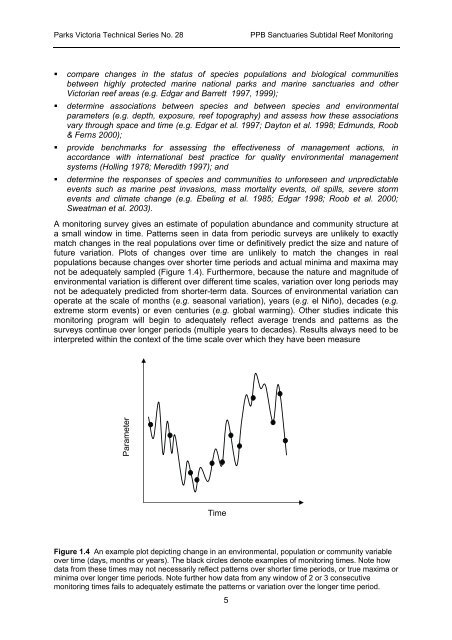Victorian Subtidal Reef Monitoring Program - Parks Victoria
Victorian Subtidal Reef Monitoring Program - Parks Victoria
Victorian Subtidal Reef Monitoring Program - Parks Victoria
Create successful ePaper yourself
Turn your PDF publications into a flip-book with our unique Google optimized e-Paper software.
<strong>Parks</strong> <strong>Victoria</strong> Technical Series No. 28PPB Sanctuaries <strong>Subtidal</strong> <strong>Reef</strong> <strong>Monitoring</strong>• compare changes in the status of species populations and biological communitiesbetween highly protected marine national parks and marine sanctuaries and other<strong><strong>Victoria</strong>n</strong> reef areas (e.g. Edgar and Barrett 1997, 1999);• determine associations between species and between species and environmentalparameters (e.g. depth, exposure, reef topography) and assess how these associationsvary through space and time (e.g. Edgar et al. 1997; Dayton et al. 1998; Edmunds, Roob& Ferns 2000);• provide benchmarks for assessing the effectiveness of management actions, inaccordance with international best practice for quality environmental managementsystems (Holling 1978; Meredith 1997); and• determine the responses of species and communities to unforeseen and unpredictableevents such as marine pest invasions, mass mortality events, oil spills, severe stormevents and climate change (e.g. Ebeling et al. 1985; Edgar 1998; Roob et al. 2000;Sweatman et al. 2003).A monitoring survey gives an estimate of population abundance and community structure ata small window in time. Patterns seen in data from periodic surveys are unlikely to exactlymatch changes in the real populations over time or definitively predict the size and nature offuture variation. Plots of changes over time are unlikely to match the changes in realpopulations because changes over shorter time periods and actual minima and maxima maynot be adequately sampled (Figure 1.4). Furthermore, because the nature and magnitude ofenvironmental variation is different over different time scales, variation over long periods maynot be adequately predicted from shorter-term data. Sources of environmental variation canoperate at the scale of months (e.g. seasonal variation), years (e.g. el Niño), decades (e.g.extreme storm events) or even centuries (e.g. global warming). Other studies indicate thismonitoring program will begin to adequately reflect average trends and patterns as thesurveys continue over longer periods (multiple years to decades). Results always need to beinterpreted within the context of the time scale over which they have been measureParameterTimeFigure 1.4 An example plot depicting change in an environmental, population or community variableover time (days, months or years). The black circles denote examples of monitoring times. Note howdata from these times may not necessarily reflect patterns over shorter time periods, or true maxima orminima over longer time periods. Note further how data from any window of 2 or 3 consecutivemonitoring times fails to adequately estimate the patterns or variation over the longer time period.5
















